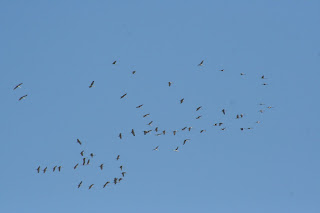Over the next few weeks I will be fielding questions from Mr. Kepler's Team 3 students at the
dePaul School as they start their science unit on birds. They will be asking me questions about birds and the landfill, and come early January I will be speaking to their class about the importance of birds and how they are different. This is a bright bunch of third graders and I look forward to their great questions! Lets begin!
Q:
What is your favorite bird and why?A: That is a tough question! There are so many types of birds, from ducks to hawks and sparrows to herons, that it is difficult to decide which is your favorite. Birds come in a stunning variety and I think all of them are amazing. If I was forced to pick one, it would have to be the Ruby-throated Hummingbird. These guys are real common and you have probably seen one drinking sugar water from a feeder on your back porch.

Hummingbirds are some of the smallest birds but they have a lot of personality. Males like the one above have bright red iridescent throat patches that they use to attract females. The red feathers sparkle like rubies when the light hits them at the right angle and that is how they got their name. They are small but they can move VERY fast. Their wings beat 53 times a second, so fast that you can hear a hum when they fly past. Since they use so much energy they must constantly eat to stay alive. Hummingbirds can eat twice their weight in a day! Can you imagine eating twice your weight in food a day? That would be a ton of school lunches!
Q:
What area of the landfill do you see the most birds?A: That is a good question. The spot on the landfill that has the most birds would be the active area, that is, the area where the garbage trucks dump the garbage. Big bulldozers push and squish the garbage into as small an area as possible, but that doesn't keep the birds from trying to eat it. Most of the birds that try to eat the trash are European Starlings, a bird that was brought over to America from Europe in the 1800's. There can be over 1,000 birds at a time trying to eat yesterday's trash as it goes into the landfill.
However, the spot with the most types of birds would be the wetlands. That is because wetlands are some of the most productive types of habitats, meaning they have the things birds want the most like food and nesting sites. All kinds of birds have been seen in the wetlands like sparrows, warblers, and herons.
Q:
What is your favorite part about your job?A: A big part of my job is that we try to scare away blackbirds and vultures because the landfill is located right next to the airport. Planes are constantly landing and taking off over the landfill and it is our job to make sure the skies are clear of birds and safe for the planes and passengers. We use different kinds of noisemakers that sound like fireworks to scare the birds away. They usually leave but often they do not go far. So we are always looking for birds to shoo away. Therefore, I would say my favorite part of my job is making sure the planes can fly safely and that they can worry less about flying into a big flock of birds.
These were great questions Team 3 and I look forward to your future questions!






 10:49 AM
10:49 AM
 Ryan Ankeny
Ryan Ankeny

























